|
Hong Kong Mangrove Fauna
Introduction
Mangrove Crabs
Mangrove Molluscs
Conservation Measures of Mangroves
Keys Sites for Visiting Mangroves in Hong Kong
Dos & Don'ts WhenVisiting Mangrove Sites
References
Introduction
Mangroves are highly productive areas that greatly contribute to the food chains of coastal oceanic areas. They provide habitats, nesting and breeding sites, and feeding grounds for countless species of birds, crustaceans and marine fauna.
Mangrove Crabs
Crabs belong to Crustacean, Order Decapoda (meaning 'ten legs', namely one pair of Chelae and 4 pairs of ambulatory legs). The dorsal side of a crab's body is covered by a carapace, the shape varying with each species – while the mouthparts and a folded abdomen are found on the ventral side. For some purely sub-tidal crabs, the last pair of legs (the fourth ambulatory legs) are paddle-liked structures to facilitate swimming. The major cheliped of crabs is used for defending invaders, fighting, attracting mate and feeding. The cheliped of male is usually larger than that of female.
The carapace width of crabs varies from a few mm, like Tmethypoecoelis ceratophora, to over 25cm such as the Australian giant crab (Pseudocarcinus gigas) found in deep waters. Crabs occur in a wide range of habitats from terrestrial to aquatic, and from freshwater to brackish water and seawater.
Many species of crabs are edible and some of them are of economic importance such as the members of Family Portunidae, including the famous 'mud crab' Scylla serrata and other swimming crabs such as Portunus pelagicus, Portunus trituberculatus and Charybdis species. The famous 'Mitten crab' Eriocheir sinensis of the family Varunidae inhabits the Mainland waters, whereas another species of similar appearance, Eriocheir japonica, can be found in Hong Kong waters.
Hong Kong, with its subtropical location and extensive coasts, has a generally diverse marine fauna comprised of species of both the tropical and temperate regions. In particular, Brachyuran have a very high diversity here, with a rough estimation of some 300 species recorded (Lee & Leung, 1999). According to the comprehensive record of brachyurans from the China seas by Dai & Yang (1991), a total of more than 800 species of marine brachyurans is found in China. Thus, Hong Kong accounts for about 30 % of the overall Chinese brachyuran fauna found, among which the most important families being: Portunidae, Grapsidae and Ocypodidae, with more than 20 species in each family.
Diversity of intertidal crabs
In Hong Kong, more than 60 species of crabs are found in the inter-tidal areas, distributed in different littoral zones.
The high inter-tidal zone, which is the transition area between terrestrial habitats and the mangrove habitats, is dominated by semi-terrestrial crabs such as Neosarmatium indicum and Chasmagnathus convexus.
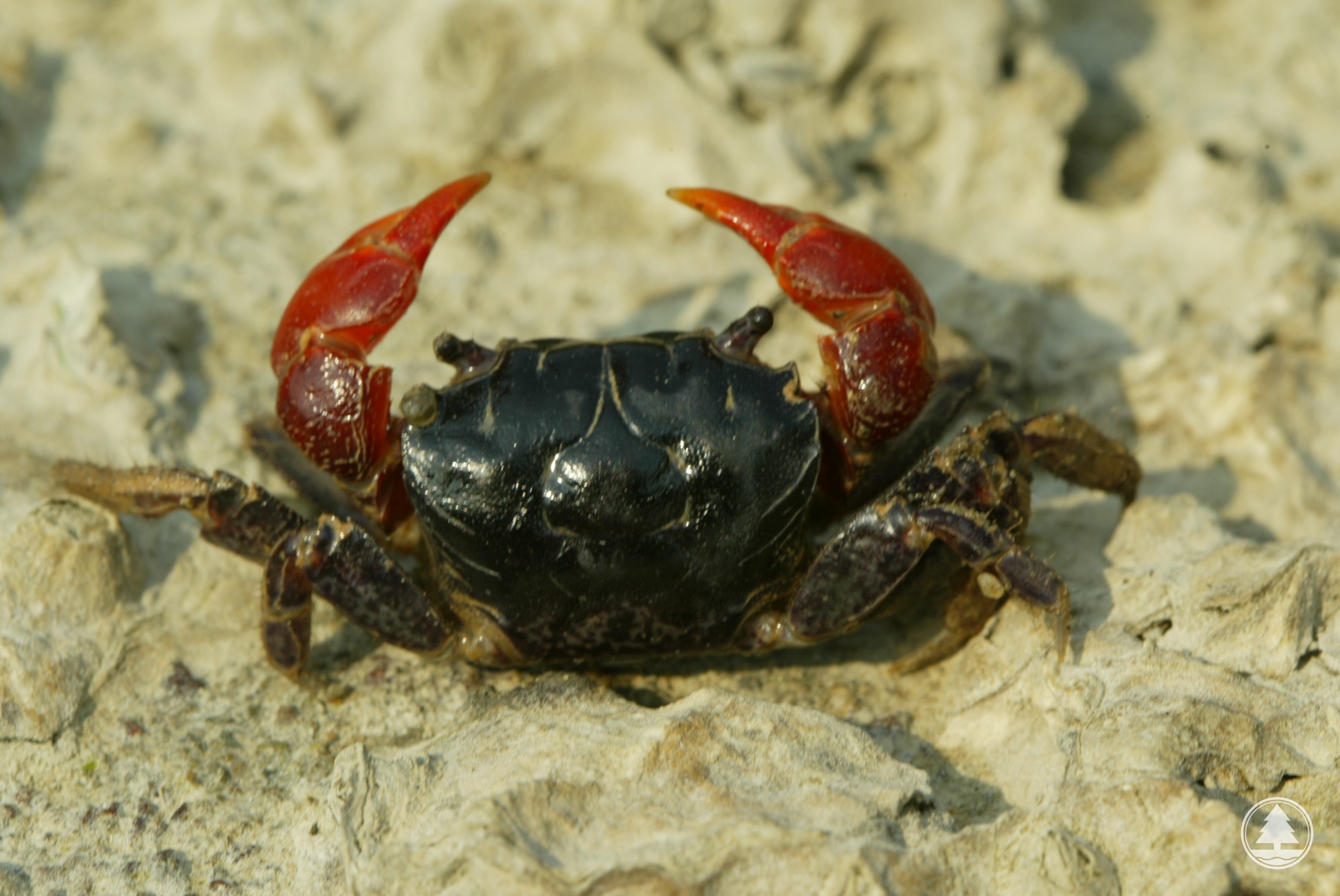 |
| Neosarmatium indicum |
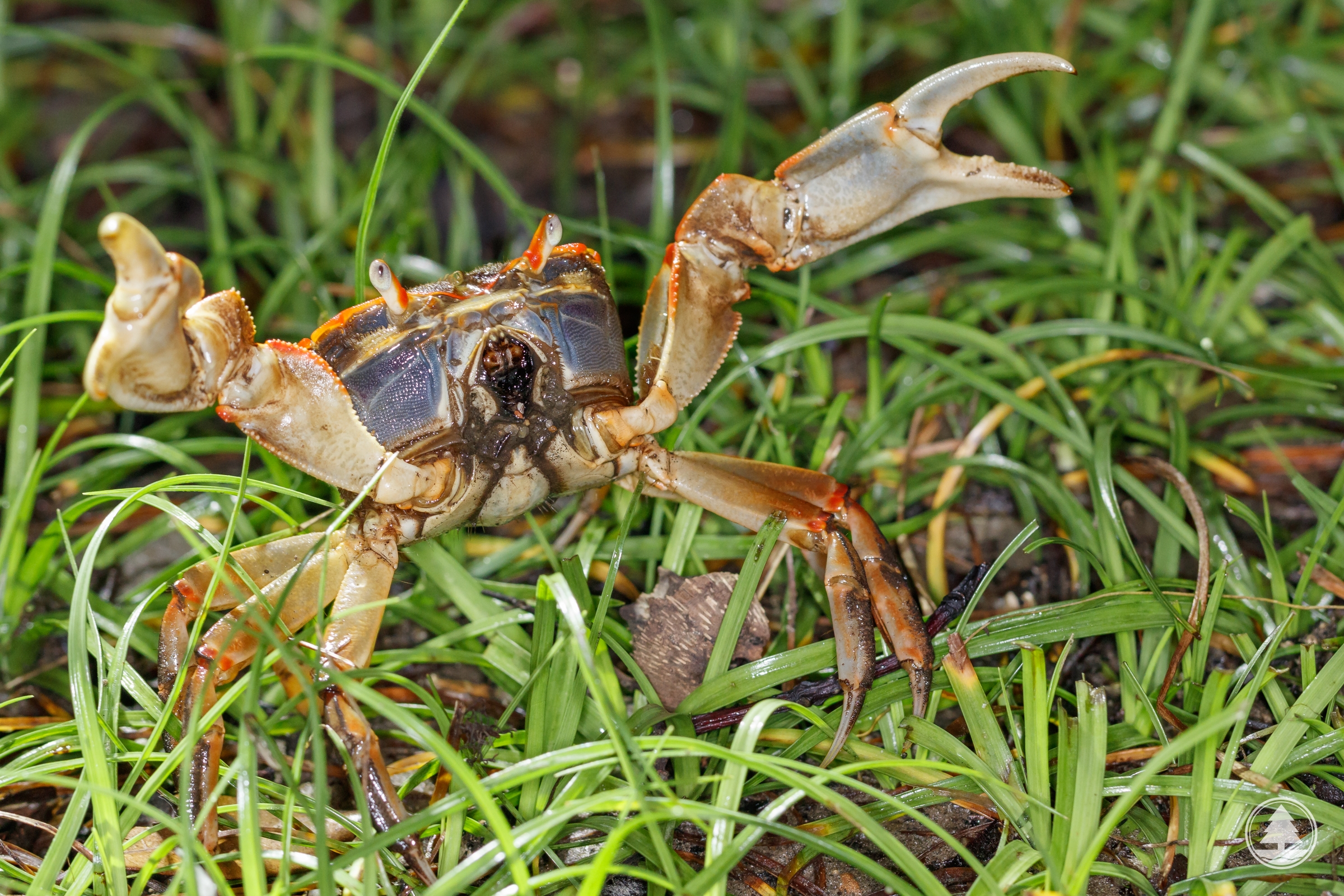 |
| Chasmagnathus convexus |
In areas where streams flow into mangrove habitats, Chiromantes haematocheir and Chiromantes dehaani are usually found along the stream banks while the supra-littoral species such as Psuedosesarma patshuni are less common.
Further to seaward, crab species are more dominated by the superfamily Ocypodoidea (including the families Ocypodidae, Macrophthalmidae, Dotillidae and Mictyridae). These crabs mostly are detritus feeders, which ingest sand and extract the detritus inside by a special apparatus in the mouthparts. The unwanted sand is excreted and, in some species such as Scorpimera, it is ejected in the form of numerous tiny 'sand balls'. As a result, some sand ball tracks originated from their burrows can be easily found on the sandflats or beaches.
In the subtidal region, the family Portunidae is dominant. They have swimming legs and most of them are edible – and thus of economic value.
Sesarmid crabs and mangroves
Inside the mangrove habitats, many ground-dwelling crabs are found, most of which belong to the family Sesarmidae. These crabs are important parts of mangrove ecosystems due to their high abundance and feeding habits. Though also taking small animals including insects, worms and even other crabs for their supplementary diet, Sesarmid crabs mainly feed on rotten mangrove leaves, seeds and branches. As such, they are capable of consuming a large amount of mangrove litter and form a significant link on the energy flow within the mangrove forest. Also, by virtue of their burrow digging behavior, the Sesarmid crabs help create air circulation around mangrove roots.
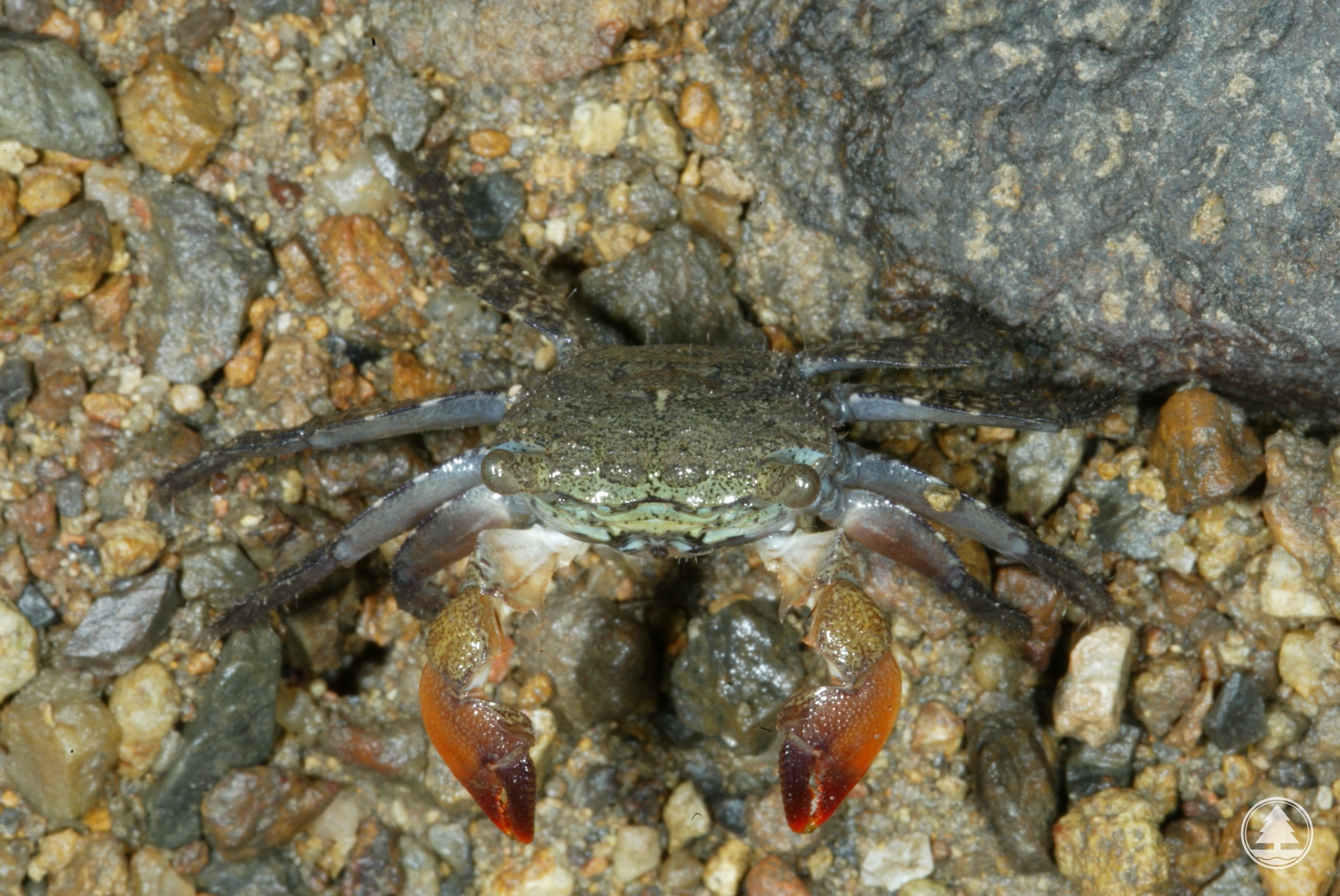 |
| Parasesarma continentale |
In order to adapt to the harsh environment of mangroves, Sesarmid crabs are tolerant to the fluctuating salinity and they are 'semi-terrestrial'. They have a hairy 'mesh' on both sides of their mouthparts, which can hold a layer of water firm. They can then 'breathe' by circulating the water to the mesh for oxygenation and then back to their gills for air exchange. Therefore they can leave the water for several hours without suffocating. Sesarmid crabs are usually small in size, with a carapace width of about 2-3 cm wide. The biggest Sesarmid crab in Hong Kong, Episesarma versicolor, has a carapace width up to 5cm.
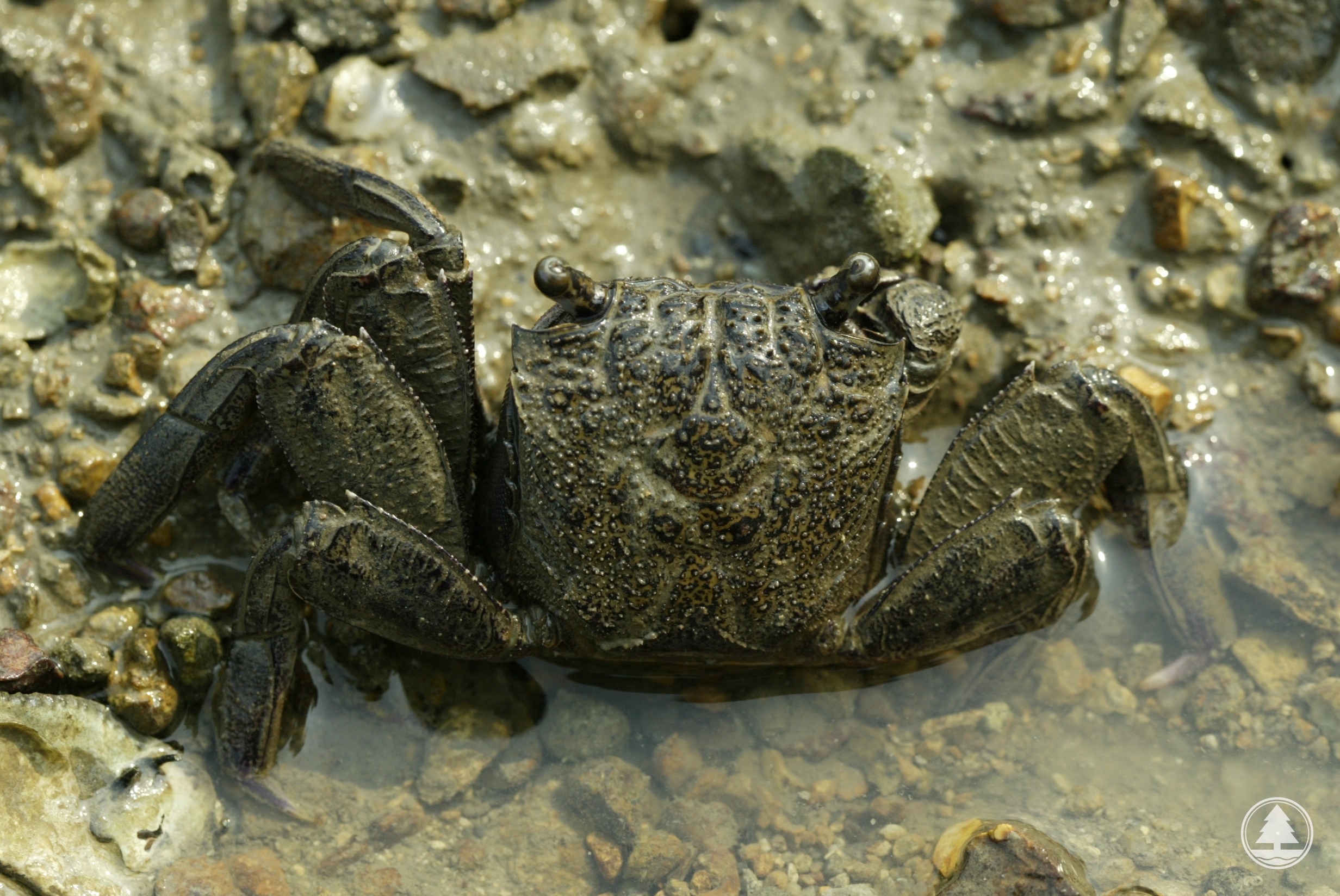 |
| Episesarma versicolor |
Mangrove Molluscs
Molluscs found in Hong Kong mangroves mainly belong to Classes Gastropoda and Bivalvia.
Gastropoda
The Gastropod (Greek gaster, 'stomach'; pous, 'foot'), which includes snails and slugs, are generally characterized by a single shell, a single foot and an asymmetric body. The shell has been totally lost, or reduced, in slugs while both snails and slugs crawl slowly, mainly using waves of muscular contraction of the single foot. Common mangrove dwelling gastropods include Batillaria which belong to the family Batillariidae; Terebralia, Pirenella and Cerithidea which belong to the family Potamididae; Nerita and Clithon which belong to the family Neritidae and Littoraria from the family Littorinidae.
Gastropods vary considerably in their structure, way of life and diet. Amongst the various gastropods found in Hong Kong mangroves, Littoraria species have the closest relationship with mangroves. They are always found crawling slowly, or adhering firmly, on the stems and foliage of mangroves where they extract plant cells, fungi and microalage from the surfaces. The two common species are Littoraria melanostoma (pale yellow shell with a distinctive brown patch on the inner lip) and Littoraria ardouiniana (variable shell colour with growth marks).
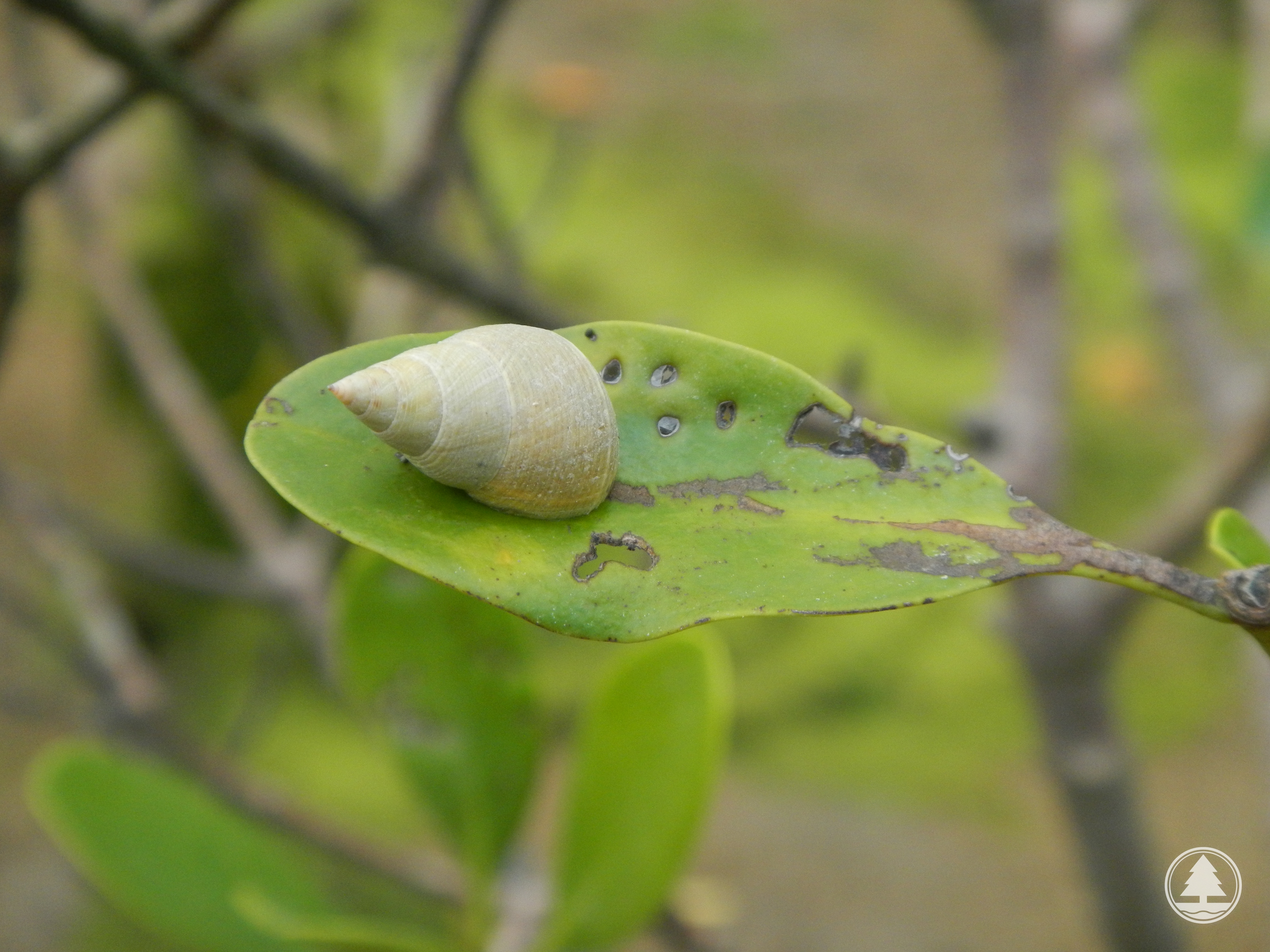 |
| Littoraria melanostoma |
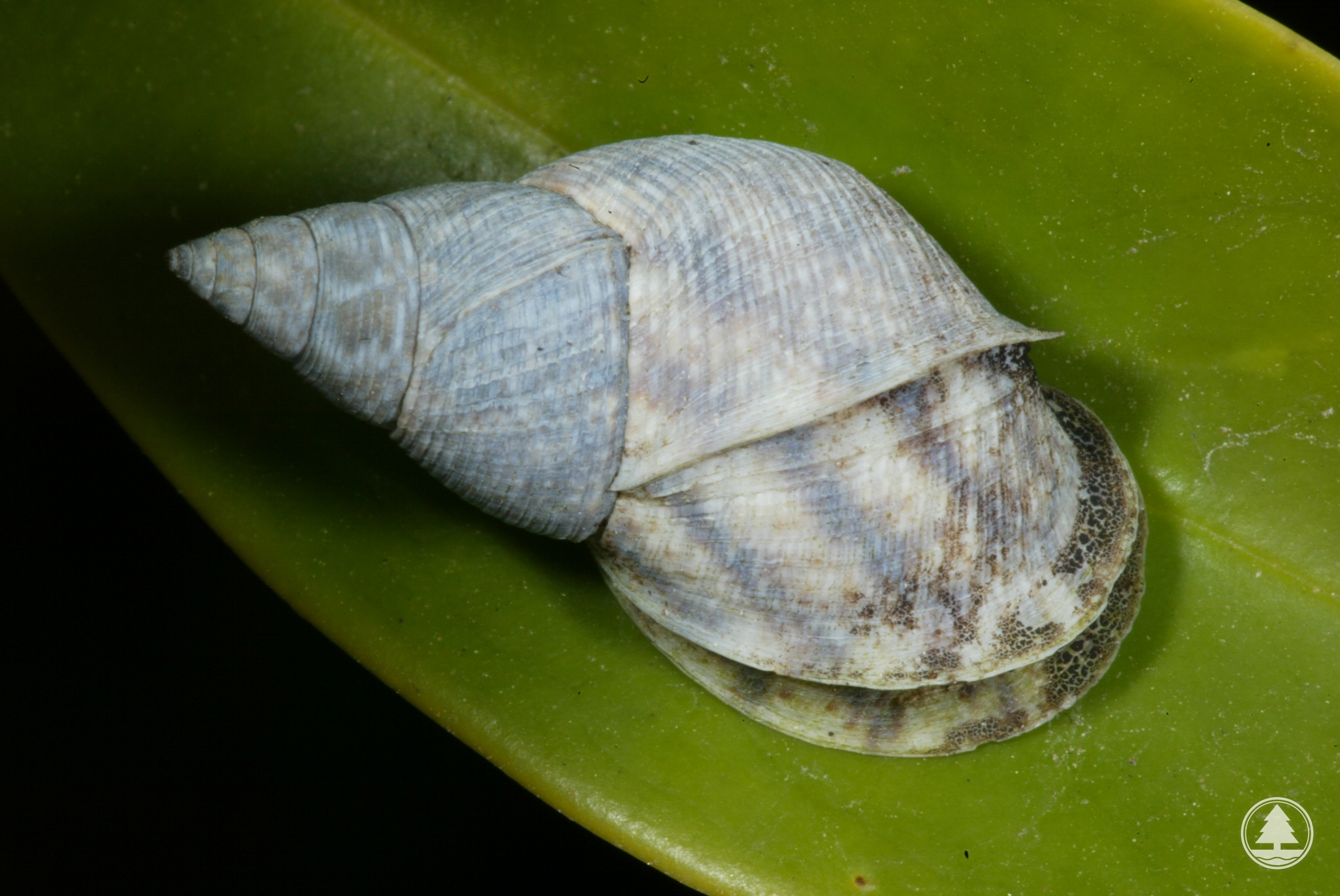 |
| Littoraria ardouiniana |
Nerita and Clithon are notable for their smooth, oval and variably patterned shells. The mouth is characteristically semicircular with a calcareous operculum. The family is rich in species, as they can live in the sea, brackish or fresh waters. All graze upon algae growing on firm underwater surfaces. Clithon faba (up to 1.5cm in shell length) and Clithon oualaniensis (up to 1cm in shell length) are always found near estuarine mangroves where the fresh water input is substantial. Nerita chamaeleon is common on stones among mangroves. Nerita balteata, the largest species of the local neritas, can be quite easily distinguished by its large, thick shell with pronounced spiral cords. They usually inhabit tree trunks on the back-side mangroves.
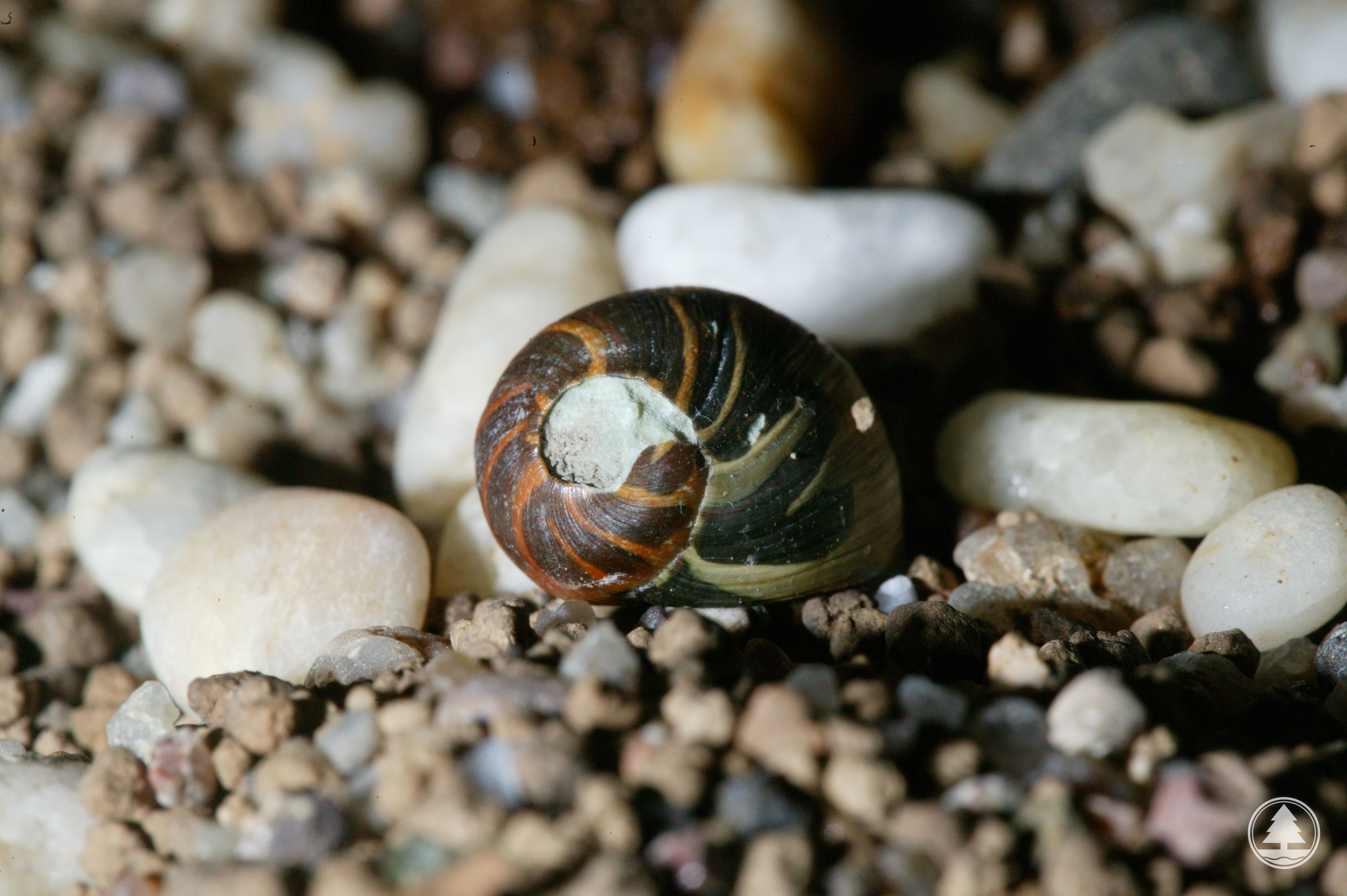 |
| Clithon faba |
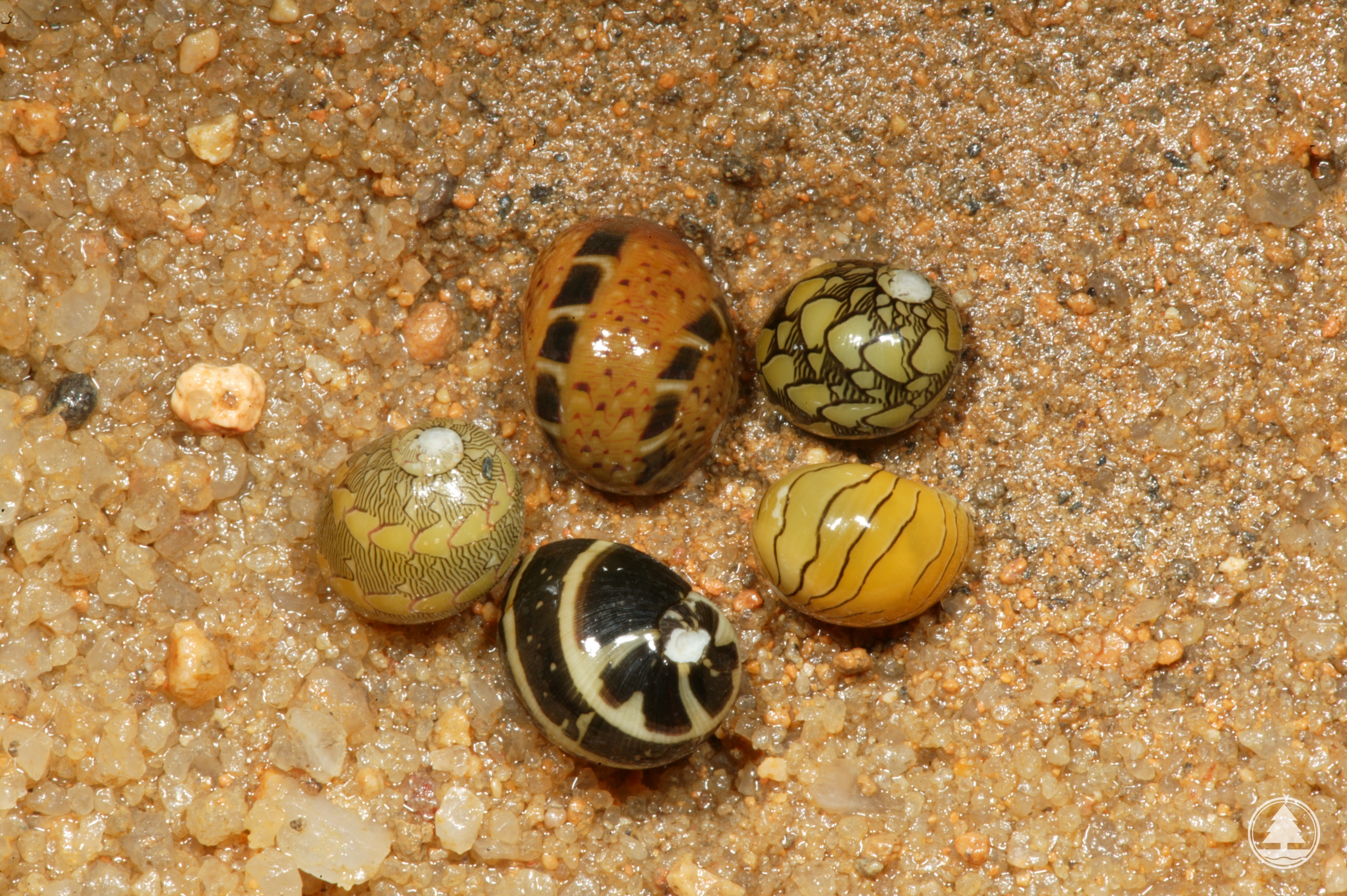 |
| Clithon oualaniensis |
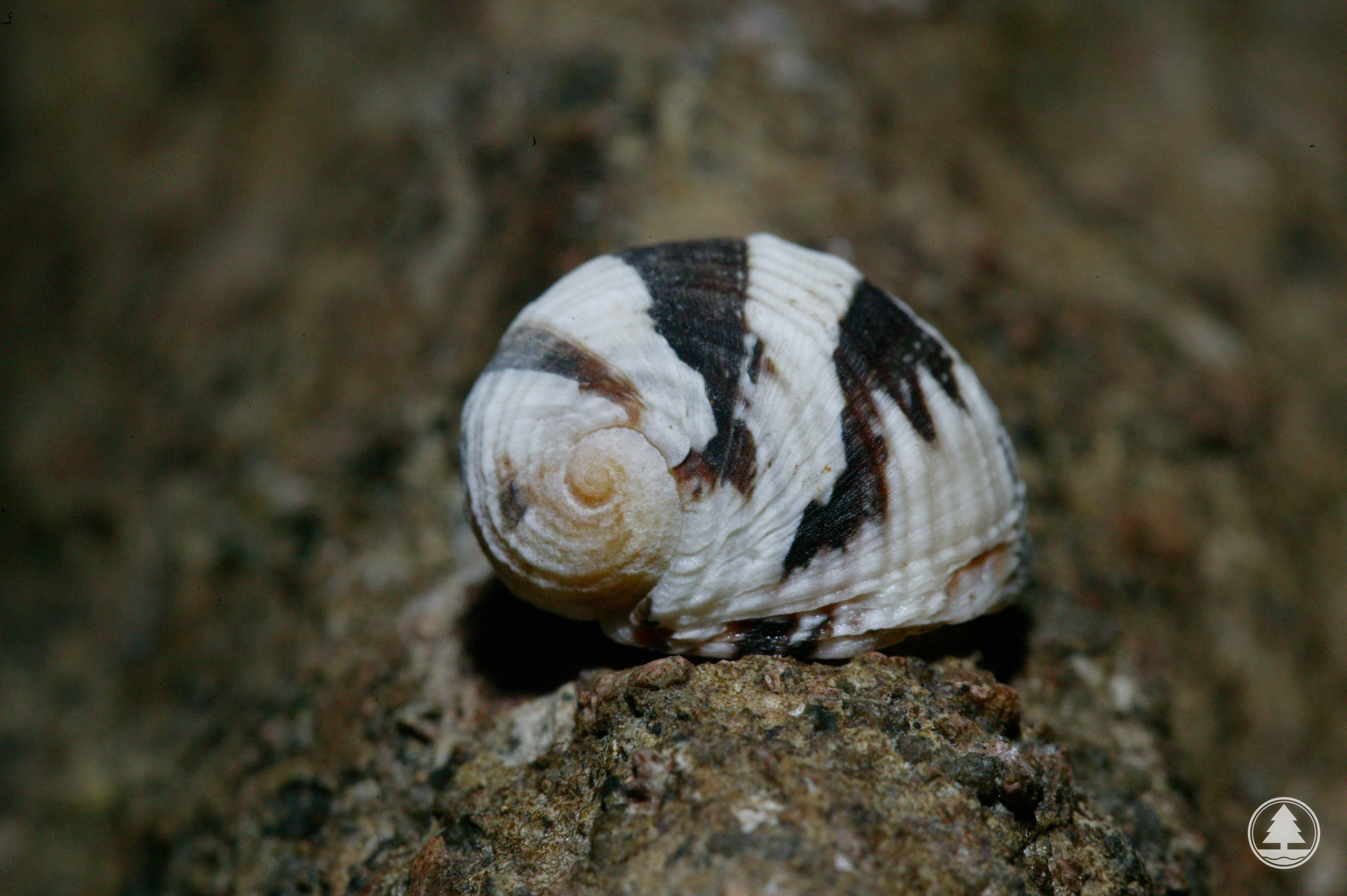 |
| Nerita chamaeleon |
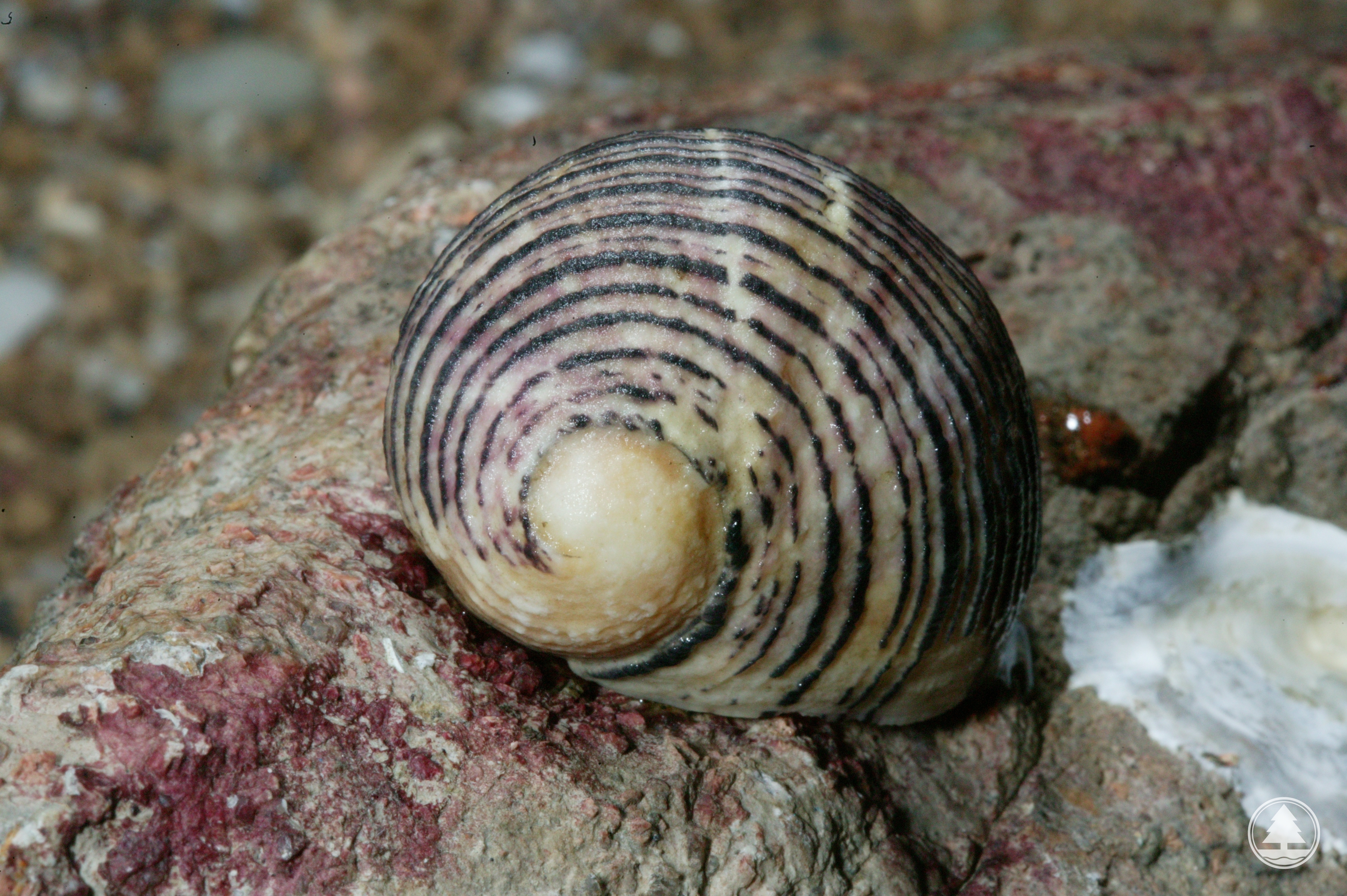 |
| Nerita balteata |
Terebralia sulcata is characterized by a round hole at the anterior end which, in fact, is the siphonal canal being enclosed progressively by the growth of the shell. There are possibly numerous species of Batillaria in Hong Kong, however they are not readily distinguishable. Batillaria zonalis bears apparent white bandings, while the outer lip of Batillaria multiformis is straight. Cerithidea moerchii is a common Cerith found in grass covered mangroves at the backside of the shore. The apical tip of the spire is usually eroded.
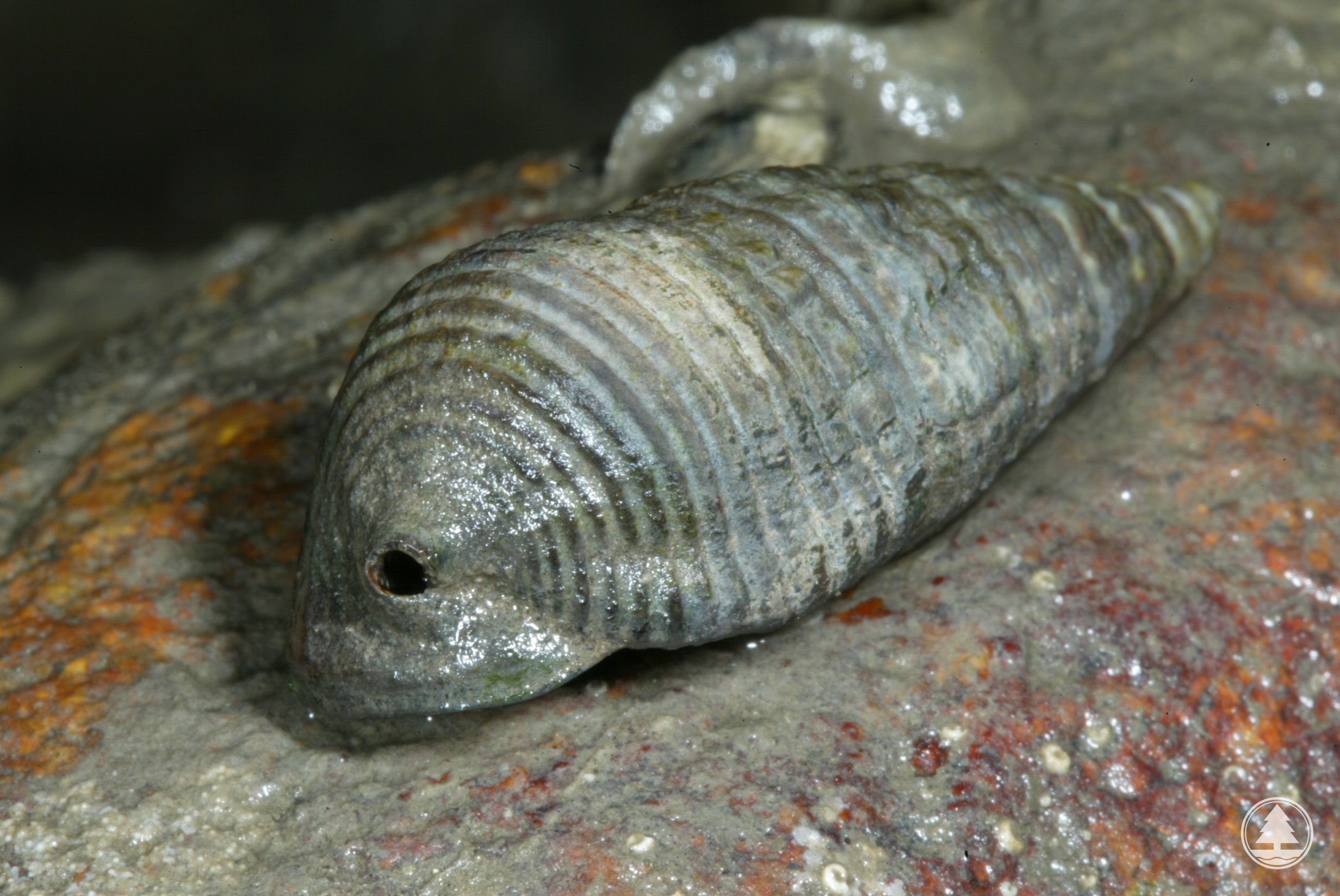 |
| Terebralia sulcata |
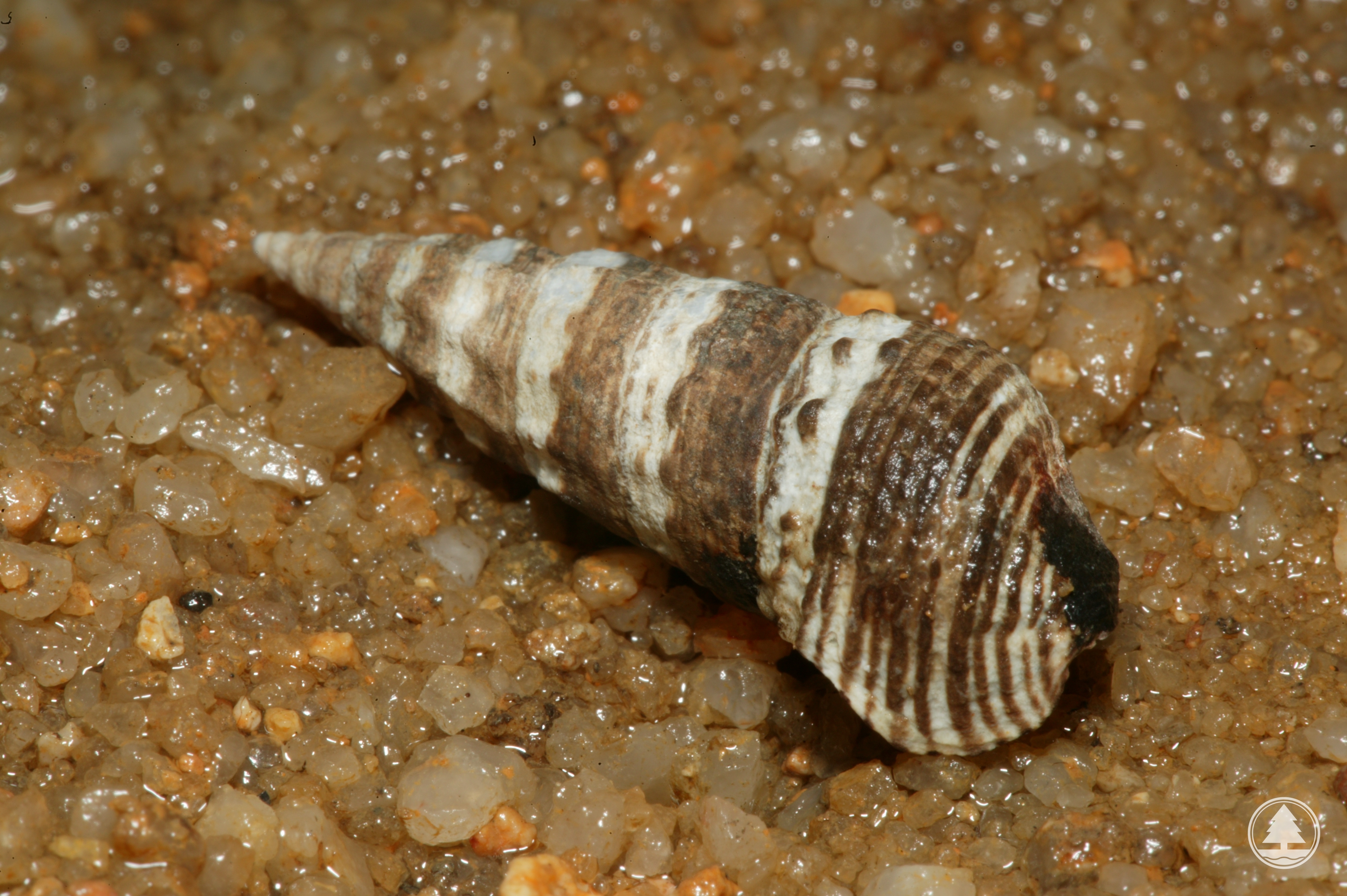 |
| Batillaria zonalis |
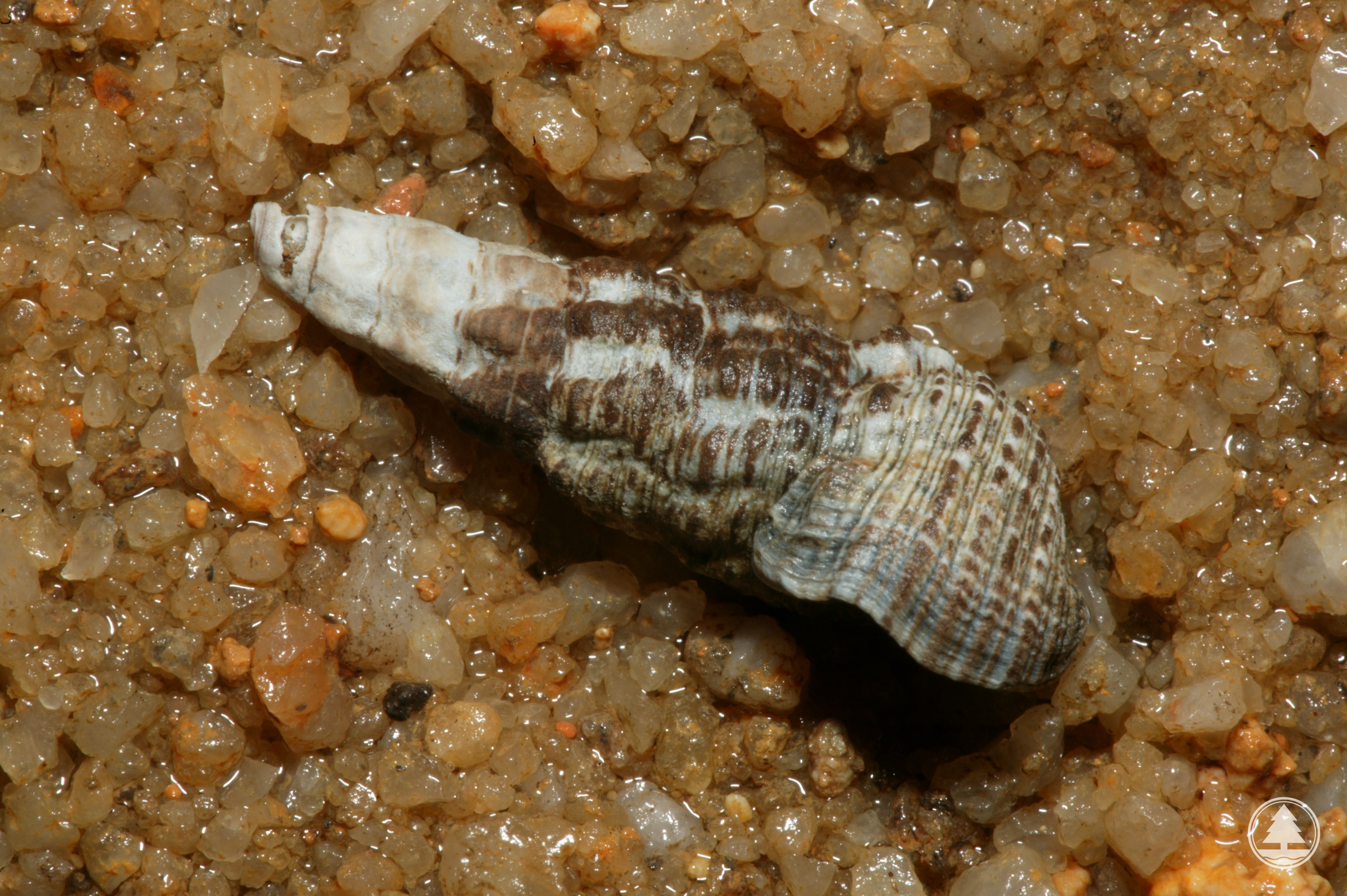 |
| Batillaria multiformis |
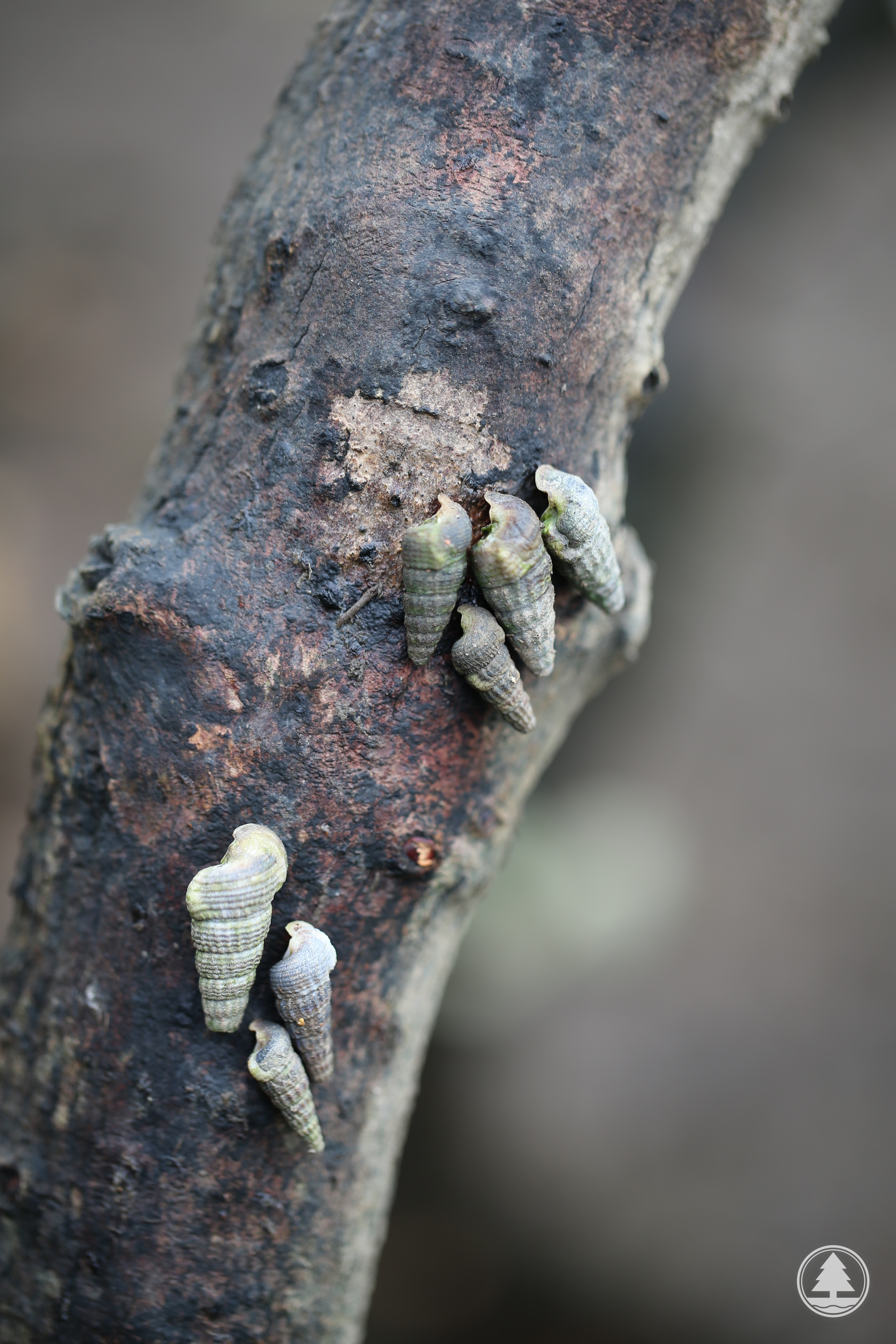 |
| Cerithidea moerchii |
Bivalvia
Bivalves, which include clams, mussels and oysters, have laterally compressed bodies, with two shells hinged by an elastic ligament. Usually the two shells are similar and equal in size. However, in some sedentary forms such as the oyster, the lower valve fused to the substratum is smaller than the upper one. Different from oysters, mussels attach themselves to the substratum with byssuss while clams using the foot, burrowing slowly into the sand or mud. Bivalvia is the only mollusc that can be classed without radula. Indeed, the gills within the mantle cavity are used for filter feeding and respiration. As water passes through the gills, tiny organic particles are filtered and transported to the mouth.
Gelonia erosa, Saccostrea cucullata, Gafrarium pectinatum and Brachidontes variabilis are representative mangroves species found locally.
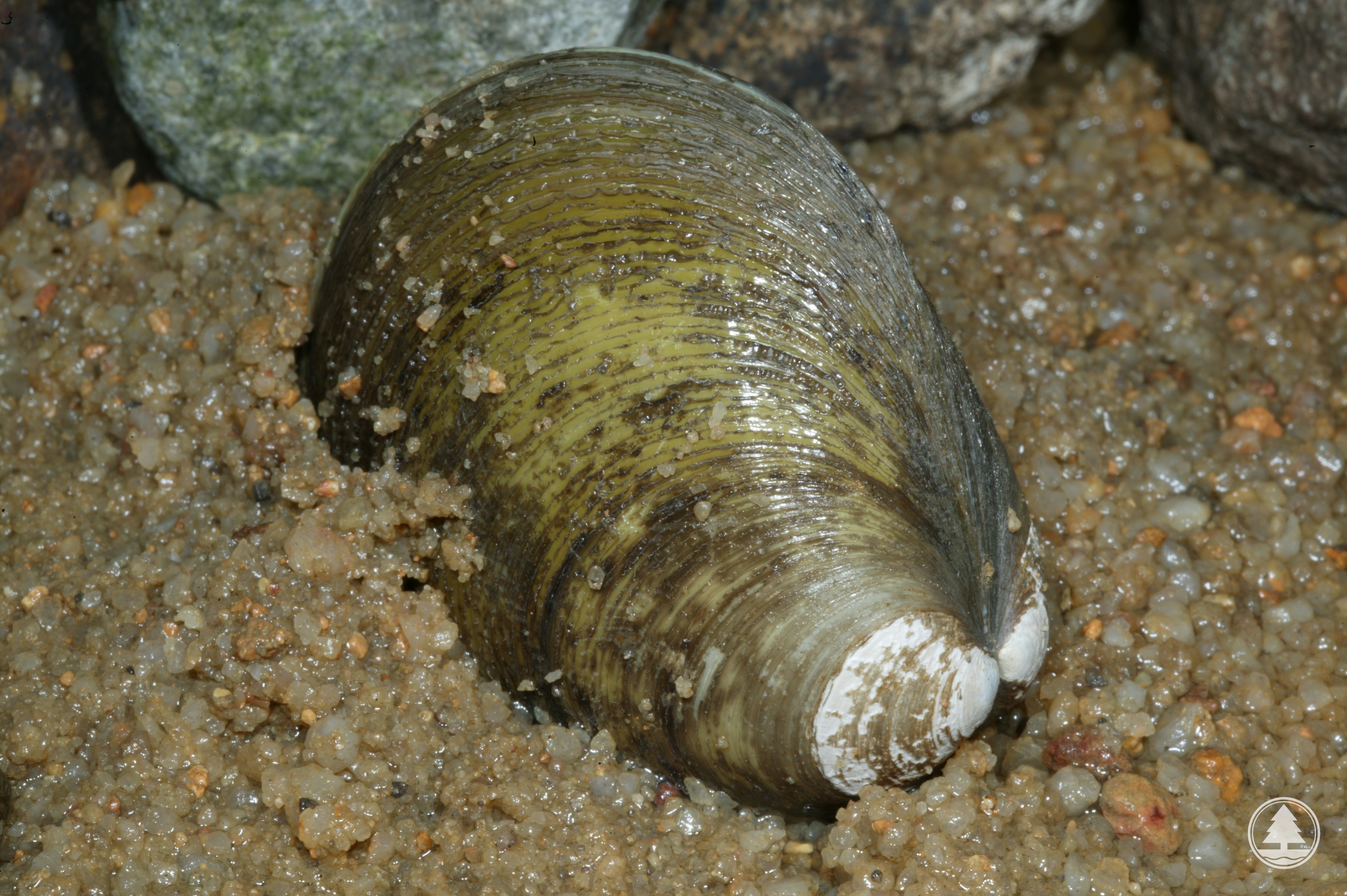 |
| Geloina erosa |
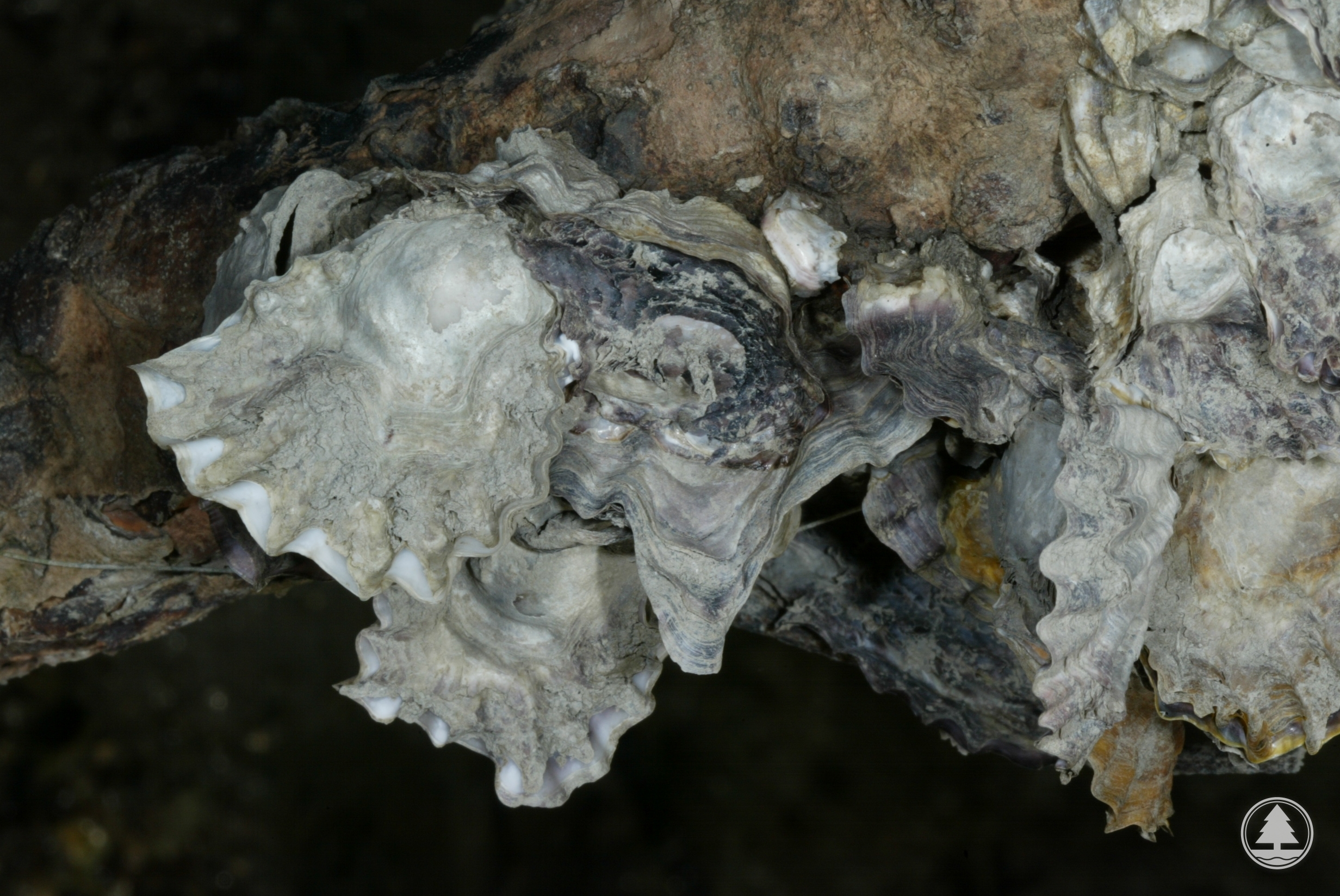 |
| Saccostrea cucullata |
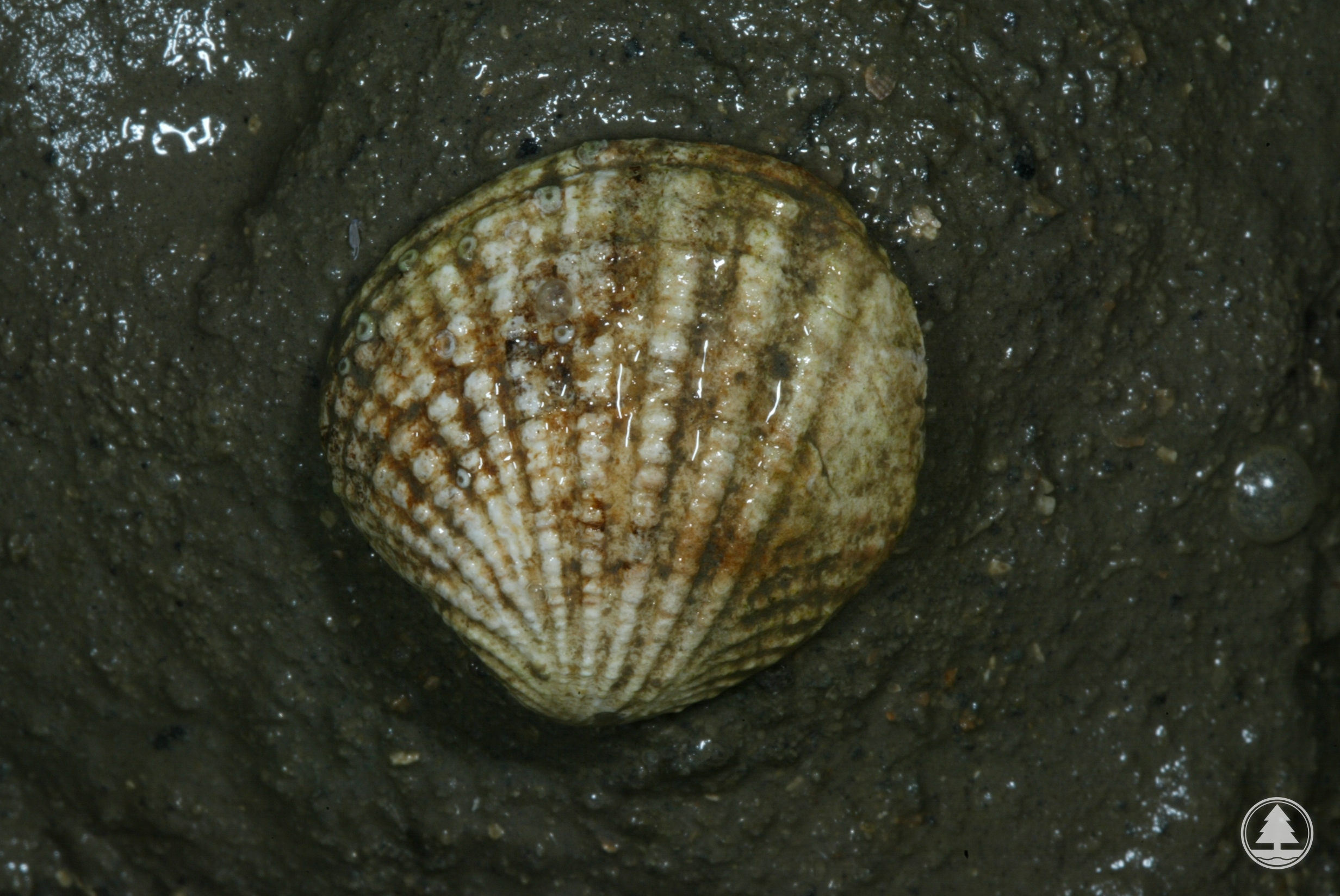 |
| Gafrarium pectinatum |
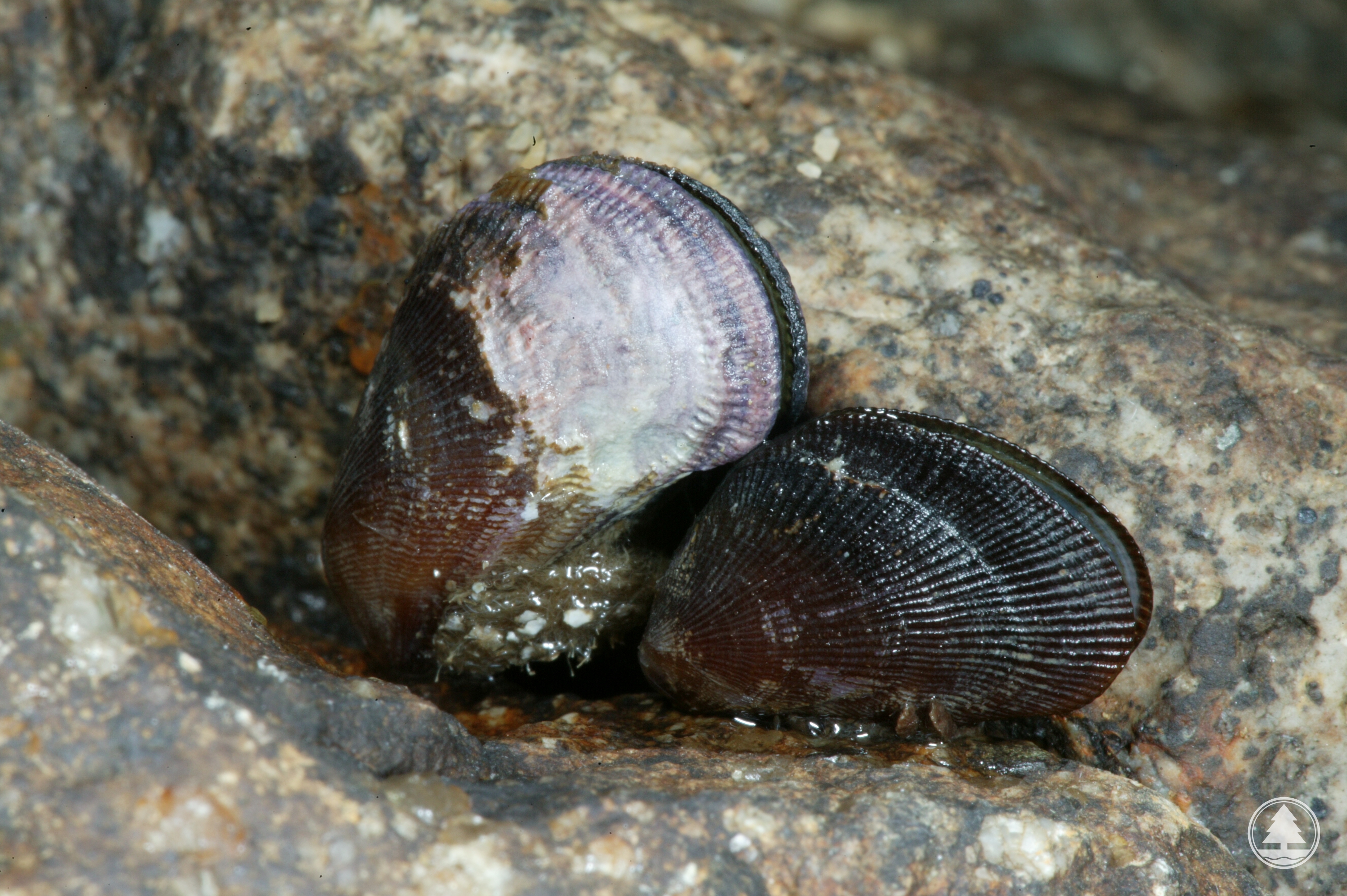 |
| Brachidontes variabilis |
Diversity of mangrove molluscs
The abundant and diverse molluscs are an important part of the food web. According to the Coastal Community Survey conducted by AFCD in 2004, a total of around 64 different species have been recorded in Hong Kong mangroves. The number of species can vary between sites from ~4 (Tsim Bei Tsui, Nam Chung and Sha Tau Kok) to ~32 (Wong Yi Chau, To Kwa Ping, Tai Tan and Chek Keng). In general, mangroves with diverse microhabitats such as rocky, boulder, sandy and muddy shores and with substantial fresh water coming in are the richest in these species.
Conservation Measures of Mangroves
Apart from the Mai Po Marshes and Tsim Bei Tsui, which are both SSSIs and also the Restricted Area under the Cap. 170 Wild Animals Protection Ordinance that is legally protected from undue disturbance, other mangrove sites in Hong Kong which are either of considerable size, or with ecological value, include Tai Tam Harbour, Lai Chi Wo Beach, Pak Nai, Ting Kok, Hoi Ha Wan, Kei Ling Ha and San Tau – which are designated as SSSIs. These SSSIs, when they are covered by existing statutory Outline Zoning Plans (OZPs) would be protected from incompatible land uses by statutory controls. Approval from the Town Planning Board is required for any developments within the SSSI boundaries. In addition, mangrove habitats are also included as one of the important habitats for designated projects (DP) under the Environmental Impact Assessment Ordinance (EIAO). This means the possible impacts from the DPs on the mangrove sites must be assessed in the Ecological Impact Assessment report. New SSSIs for mangrove sites will be proposed when more information is available on the ecological values of the mangrove sites.
Keys Sites for Visiting Mangroves in Hong Kong
| Ting Kok |
Being one of the largest mangrove stands in Hong Kong, the 7-hectare Ting Kok mangrove stand is easily accessible and has a rich diversity of mangrove and fauna species. Along the coastline 6 of the 8 true mangrove species can be found, which include Kandelia obovata, Aegiceras corniculatum, Avicennia marina, Lumnitzera racemosa, Excoecaria agallocha and Bruguiera gymnorrhiza. Most of them are short, which reflects the coarse substratum and high salinity of the site. Common fauna species such as Terebralia sulcata and Parasesarma continentale can be found occupying the shaded area under the mangroves. |
| Sai Keng |
This mangrove stand is located at Tolo Channel and has high ecological value. The mangrove assemblage is dominated by Avicennia marina and Kandelia obovata which is similar to most other mangrove stands in Hong Kong, although significant occurrences of Aegiceras corniculatum, Excoecaria agallocha and Bruguiera gymnorrhiza are also observed. These mangrove trees provide additional surfaces for attachment by sedentary organisms, such as oysters and barnacles. Due to large amount of freshwater runoff and possibly high nutrient supply from mariculture operations nearby, the mangroves there are tall. Also, the fine substratum encourages growth of many silt feeding and burrowing organisms, such as the calm Gafrarium pectinatum. |
| Shui Hau |
Small and scattered patches of mangroves are found in this small embayment on the southern coast of Lantau. Apart from mangrove species, the salt-tolerant grass, Zoysia sinica, can also be found. Zoysia sinica provides an excellent habitat for crabs such as Austruca lactea and Gelasimus borealis to hide and feed. Apart from crabs, the grass floor is also densely inhabited by many small, air-breathing marine snails. |
| Lai Chi Wo |
It is remote from urban areas, which is nestled between hills of the far northeastern corner of Hong Kong. The mangrove stand in front of the village is remarkable that Derris trifoliata grows and climbs through a large patch of tall Heritiera littoralis. There is no other place with such a scene in Hong Kong. |
| Luk Keng |
The mangroves around Luk Keng can be easily accessible by car or public transport. Locating just beside Luk Keng Road, the place is popular with travelers in weekends. The extensive mudflats and mangroves offer good opportunities for bird watching. The substratum of the site is soft and could be dangerous, please be careful not to venture out too far to the open mudflat. |
| Tai Tam |
This site is classified as Site of Special Scientific Interest and represents the last remaining mangrove stand in Hong Kong Island. With little mangrove growing in the area, Tai Tam mangrove stand is surprisingly rich in benthic macrofauna diversity. Rich assemblages of small grapsid and ocypodid crabs can be found on the extensive stony marsh and sand flat, while sesarmid crabs dominated the mangrove area. |
| Hoi Ha Wan |
Hoi Ha Wan is well-known for its Marine Park status and the beautiful underwater corals. Freshwater from streams leading to the bay dilutes the salty seawater and thus provides an acceptable environment for a small patch of mangroves to grow at the river mouth. Dwarf individuals of Kandelia obovata, Aegiceras corniculatum and Excoecaria agallocha are as a result of the physical environment there: coarse substratum, high salinity and expose to wind. These conditions altogether limit mangrove growth. |
| Chek Keng |
Located at the south end of Long Harbour, Chek Keng has a relatively undeveloped environment. Mangroves typical of eastern half of Hong Kong can be found there. Chek Keng has 7 of the 8 true mangrove species occurring in Hong Kong, which is an ideal location for studying the distribution, structural diversity and adaptation of various mangrove species on the shore. |
Dos & Don'ts When Visiting Mangrove Sites
-
Always wear sports shoes and long trousers to protect your feet from the sharp stones and mangrove roots. Do not wear flip-flops.
-
Do not catch crabs. You may get hurt by the chelipeds of crabs when they defend themselves.
-
Check the tide before you visit a mangrove site. The best time to visit mangroves is during low tide. You may check the tide table in the website of Hong Kong Observatory. However the time of the tide can be affected by many factors, including rainfall and wind. Be aware of the environment during your visit.
-
Early morning or dusk during summer and low tide periods are the best time to observe crabs in mangrove sites. As the crabs are alert to any movement, to see them you must stay as still as possible, be patient and use binoculars.
-
Keep quiet when you are in a mangrove site.
-
Do not destroy vegetation, wildlife and the living environment.
-
Do not bring any animals or plants home. Remember they belong to nature, not to you.
-
Do not litter or pollute the water.
References
Dai, A.Y., and Yang, S.L. (1991). Crabs of the China Seas. China: China Ocean Press Beijing.
Lee, S.Y., and Leung, V. (1999). The brachyuran Fauna of the Mai Po Marshes Nature Reserve and Deep Bay, Hong Kong. Hong Kong: Hong Kong University Press.
Lee, S.Y. (2003). Venturing Forest in the Water. Hong Kong: Friends of the Country Park and Cosmos Books Ltd.
Tam, N.F.Y., and Wong, Y.S. (1997). Ecological Study on Mangrove Stands in Hong Kong.
Tam, N.F.Y., and Wong, Y.S. (2000). Hong Kong Mangrove. Hong Kong: City University of Hong Kong Press.
李榮祥 (2001)。台灣賞蟹情報。台灣:渡假出版社有限公司。
陳育賢 (2001)。海岸生物(一) - 臺灣潮間帶生物700種(一)。台灣:渡假出版社有限公司。
陳育賢 (2001)。海岸生物(二) - 臺灣潮間帶生物700種(二)。台灣:渡假出版社有限公司。
陳育賢 (2001)。海岸生物(三) - 臺灣潮間帶生物700種(三)。台灣:渡假出版社有限公司。
胡忠恆、陶錫珍 (1995)。臺灣現生貝類彩色圖鑑。台灣:國立自然科學博物館。
|